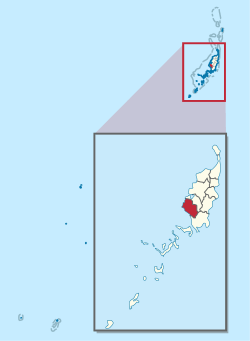Aimeliik
Aimeliik (Japanese: アイメリーク州) is an administrative division of the island country of Palau. It is one of the Republic of Palau's 16 states. It has an area of 52 km² and a population of 334 (census 2015). State capital is the village of Mongami. Following the four other villages which are: Medorm, Imul, Elechui and Ngmechiangel.
Aimeliik | |
|---|---|
 Flag | |
 Location of Aimeliik in Palau | |
| Country | |
| Capital | Mongami |
| Government | |
| • Governor | Demei Obak |
| Area | |
| • Total | 52 km2 (20 sq mi) |
| Population (2015) | |
| • Total | 334 |
| • Density | 6.4/km2 (17/sq mi) |
| ISO 3166 code | PW-002 |
The island is the location to Palau's largest powerplant. The state is also a short distance from the international airport. In the village of Medorm there is the highest powered short wave radio station in Palau. This is owned and operated by High Adventure Ministries originally from the USA but now owned by a consortium of Chinese national churches. It comprises four short wave transmitters two are Thomson which originally came from Adventist Radio in Guam the others are a venerable Harris transmitter and a 30-year-old RCA transmitter all feeding several stacked curtain arrays which are beamed on South East Asia. They operate mainly on the 9 and 15 MHz Bands.
Geography
Aimeliik is situated on the southwest corner of Babeldaob Island and it is encompassed of different types of terrains such as mangrove, swamps, rolling hills, and some steep and rugged terrains. The inhabited villages in Aimeliik include (along the coast from south to the north): Imul, Ngerkeai, Chelechui, Ngchemiangel, and Medorm. The Aimeliik boundary to the north is the Tabcheding River, to the east side is the Rael Kedam ( the central ridge on Babeldaob Island), and on the southeast the boundary lies along a ridge to within a kilometer or so (south of Ngerderar River). Aimeliik is also known for its terraces, which were most likely built for agriculture and defense reasons. The state also contains one of the four Palauan bais, or men's meetinghouses, the other three are in Koror, Airai, and Melekeok.
Aimeliik is also known for its terraces, which were most likely built for agriculture and defense reasons. The state also contains one of the four Palauan bais, or men's meetinghouses, the other three are in Koror, Airai, and Melekeok.
History
Aimeliik is one of the most ancient villages in Palau. It is best known for its terraces and modern bai. Aimeliik is also known for Malsol's Tomb, the legendary spot where the warrior Malsol is buried, which is now accessible through the main road and near the Aimeliik bai. Aimeliik is commonly passed through on the main road of the Babeldaob Island.
Commercial/agricultural developments
Large area of the commerce and farming come from Nekken. Most farm are substantial farming but there was also the attempt to establish Aimeliik State's first cattle pasture, but Palau's soils, forage and climate are ill suited to open grazing cattle operations.
Access
Most of the roads in the state are connected with dirt roads, excluding the recently completed paved, compact road which runs through the state. The major Airai-Aimeliik route is along the Compact Road (the Airai-Aimeliik route, which travels by the coast, was an old Japanese era route). This can bring you from the airport to the State of Aimeliik.
Education
The Ministry of Education operates public schools.
Aimeliik Elementary School was established in 1948.[1]
Palau High School in Koror is the country's only public high school, so children from this community go there.[2]
References
- "Aimeliik Elementary School Archived 2018-10-10 at the Wayback Machine." Ministry of Education (Palau). Retrieved on February 22, 2018.
- "About Archived 2018-03-03 at the Wayback Machine." Palau High School. Retrieved on February 22, 2018.